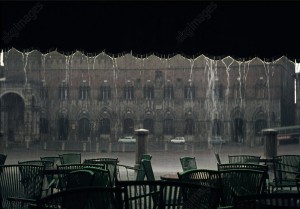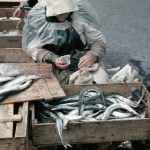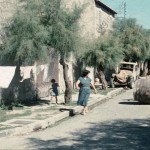Making a connection – through the lens of an amateur photographer
I can still get excited about photos even after spending most of my professional life looking at them! Recently we were given the slide collection of an amateur photographer who happened to be one of my school friends’ grandfathers. He had died quite suddenly and, as so often happens, the family was left with a house full of things including three moving boxes of slides. I have always found it strange when family photos end up at flea markets and luckily archives like ours can preserve these images and let them tell their stories.
Dr. Bernhard Wübbel was born in 1921 and studied medicine during the war, working mainly in field hospitals during and POW camps after the war. He was one of the first physicians to treat the liberated prisoners in the Bergen-Belsen concentration camp; his recollections of this time are preserved by the Bergen-Belsen memorial trust. He worked as a physician and surgeon and loved to travel, play music and paint. He died in September 2013 while on holiday.
As I am looking through each box of slides I feel as if I am getting to know this man even though I have never met him. I see him on some of the slides, probably taken by his wife or other travelling companions. Bernhard Wübbel is becoming more familiar with each passing year of holiday snaps. He is part of the generation of Germans who took the earliest opportunity after WWII to travel around Europe and – almost as close to cliché as possible – first in a BMW Isetta and later on in VW Beetle. The earliest photos we have in the collection are from 1954, the year Germans were allowed to exchange money again at a maximum of 1500 Deutschmark a year. In 1955 a survey found that 79% of Germans didn’t have a passport and that only 24% had been abroad since the war which makes these images especially interesting to me. The excitement of seeing new destinations is evident in the photos as is the enjoyment in the journey itself. I see the world through his eyes and I can relate to what I see.
I love the way he is impeccably dressed with suit, tie and hat in almost every picture. I love his view of the unfamiliar world of Southern Europe. Tourism was only just beginning and his images give a real insight into the life in the cities and villages in southern Italy, former Yugoslavia and Southern France, street photography at its best, snapshots of a different world in a different time. This is the kind of street photography which is becoming rarer in our digital world. Restrictions are imposed on photographing monuments and privacy issues prevent us from taking photographs of people in the streets. Some of these photos tell a story that will probably be different to every viewer which makes looking through them so exciting!

© akg-images / B.Wübbel
I had no idea what to expect when I got the boxes delivered and although I haven’t quite finished cataloguing all of the images, it has become clear that this collection is a real treasure trove of amateur photography. I hope you like them as much as I do and I don’t mind admitting that I have fallen a little bit in love with this man that I have never met.
For more photos in this fabulous vintage archive go to our website!





